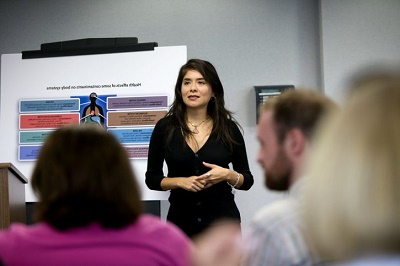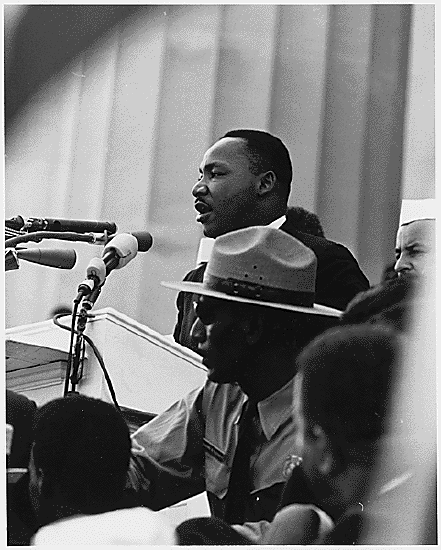10.2: The Purposes of Public Speaking
- Last updated
- Save as PDF
- Page ID
- 147049
Learning Objectives
After completing this section, students should be able to:
- describe how public speaking differs from Interpersonal Communication and Small Group Communication.
- apply the traits of a good speech in creating and presenting a speech.
- describe the general speech purposes.
The oldest form of public communication and the precursor to mass media is the simple act of one person rising and expressing their thoughts to the group. Public discourse is the foundation of society; it is how groups of people address and resolve differences collectively and peacefully. With the rise of democracy in Ancient Greece, the value of public speaking gained prominence. A citizen's ability to speak their mind in public was highly valued and a sign of civic engagement.
Although we have so many avenues to express ourselves, from in-person to online, the ability to craft and share a thoughtful, intelligent message is still an important skill. For a person's career, civic involvement, and political engagement, becoming proficient in public speaking is highly valuable.

The Nature of Public Speaking
Public speaking has three striking characteristics that set it off from interpersonal communication and small group communication.
First, public speaking is the act of one person speaking to many. Instead of focusing on an interactive nature, public speaking focuses on one person, the speaker, developing and presenting a message to a group of individuals.

Second, public speaking is a more formal presentation, meaning it is bound by specific strategies and techniques. Good public speaking requires more planning, development, and self-reflexiveness than the other two contexts.
Third, in the other two contexts, we see all members communicating from a position of shared, equal responsibility. In public speaking, the speaker bears more responsibility as the message is one-directional, and the feedback the speaker receives from the audience is subtler, such as facial expressions, body posture, and fidgeting. Public speaking is still an interaction, just like an interpersonal and small group, but the responsibility for success is less balanced with more responsibility being placed on the speaker.

A "Good" Speech
Unfortunately, for most people, our exposure to public speaking has left us with a distorted view of what makes a "good" speech. Virtually anytime we ask a class, "What is the first thing that comes to mind when you think of listening to a speech," the answer is "boring." This does not have to be the case; it is the job of the speaker to make choices that directly influence how interesting or boring a speech is going to be.

As speakers, we have the obligation and ability to choose how effectively and dynamically we will present ourselves and the information to the audience. We can give interesting, dynamic, energetic, and engaging speeches. Each of us has experienced teachers who were boring and monotone, but we have also experienced teachers who were dynamic and energetic. The latter group chose to make the speeches (lectures) more interesting. To make a speech more interesting and effective, we need to understand what makes a good speech:
- A good speech is well structured and signposted to enhance clarity and memory value. A good speech is organized and easily followed with clear, obvious transitions. Our job as speakers is to present a message clearly and thoughtfully, and a clear structure facilitates that.
- A good speech should sound like an "organized conversation." The phrase is meant to invoke the image of a speaker presenting naturally and comfortably; just talking to the audience, in an organized, easily followed manner.
- A good speech has a purpose, clear to the audience and to which the speaker adheres. Good speakers make their purpose clear, and they fulfill that. They do not wander, drift about, shift purposes, or mislead the audience. They do not start off informing the audience, and then suddenly shift to persuasion.
- A good speaker is active, not passive. Too many speakers, especially novice speakers, tend to use the "open my mouth, let the words fall out" approach to speaking. This thoughtless approach to public speaking is not effective. Good speakers make choices, determining throughout their speech the best strategy for the given audience. Through the preparation and practice process, we make decisions based on what we think will increase the likelihood of success. Such strategic thinking requires careful consideration of the topic, the audience, the speaker, and knowledge of the interaction of these three components.

- A good speaker works to create immediacy with the audience. Immediacy is a sense of connection; that the speaker, the topic, and the audience are all working together. Good speakers see a speech as a time to share a message with an audience, building a bridge between the speaker and the audience. Too often novice speakers see the audience as a barrier to success, a collective of judgmental individuals out to embarrass the speaker. However, that is simply not true for most audiences. Audiences want the speech to be good because it validates the time spent listening, it is more enjoyable, and it simply makes the time go faster. If a speaker taps into the audience's interests and personality, they can be quite effective in engaging the audience. Such engagement does not happen automatically; it is the result of thoughtful planning and preparation.
The public speaking situation is quite different from interpersonal communication and small group communication. The degree of advanced planning, conscious decision-making, and communicator responsibility is much higher when giving a speech. We have been taught that when a person goes to the front of the room to speak, the speaker is now "in charge" of the event. We must meet that expectation, take charge of the event, and fulfill our responsibilities for success. Speeches are only as good as the audience thinks they are; the speaker must rise to the challenge of presenting a good speech.
General Speech Purposes
When developing a speech, we need to know why we are speaking. Before even considering the topic, we need to know if our purpose is to inform, persuade, entertain, or if it is a special occasion.
Speeches to Inform
Speeches to inform are those in which we are aiming to enlighten or to further educate the audience, but in an objective, non-directive manner. We provide the information about the topic to the audience, but we are not directing the audience to believe, feel, or act in a specific manner.
There are four types of informative speeches.
- Objects: The term “objects” encompasses many topics we might not ordinarily consider to be “things.” It’s a category of speech that discusses the history or development of people, institutions, places, substances, and inanimate things. The following are some of these topics: Catherine the Great, Dream catchers, Aristotle, Hubble telescope, Seattle’s Space Needle, Malta, Silicon chip, Spruce Goose, Medieval armor, DDT insecticide, Soy inks, and NAACP.
- Processes: If your speech topic is a "process," your goal should be to make a speech that helps your audience understand it or be able to perform it. In either instance, processes involve a predictable series of changes, phases, or steps. The following are some of these topics: Soil erosion, Cell division, Physical therapy, Volcanic eruption, Paper recycling, Consumer credit evaluations, Scholarship money searches, Navy Seal training, Portfolio building, and the development of Alzheimer’s disease.
Organizing your facts is crucially important when discussing a process. Every stage of a process must be clear and understandable. When two or more things occur at the same time, as they might in the development of Alzheimer’s disease, it is important to make it clear that several things are occurring at once. For example, as plaque is accumulating in the brain, the patient is likely to begin exhibiting various symptoms.
- Events: An "event" can be something that occurred only once or an event that is repeated. The following are some of these topics: the murder of Emmett Till, the Iditarod Dogsled Race, the Industrial Revolution, the discovery of the smallpox vaccine, the Bikini Atoll atomic bomb tests, the Bay of Pigs, the Super Bowl, and the Academy Awards.
- Concepts: "Concepts" are abstract ideas that exist independent of whether they are observed or practiced, such as the example of social equality that follows. Concepts can include hypotheses and theories. The following are some of these topics: the glass ceiling, Ethnocentrism, Honor codes, Autism, Karma, Wellness, Fairness theory, Bioethics, The American Dream, and Social equality.
Speeches to Persuade
Speeches to persuade are those in which we are aiming to influence the audience in some fashion. They are subjective and highly directive. The speaker has a bias toward a specific belief, attitude, or action, and the speaker works to direct the audience on what to believe, what opinion to have, or what action to undertake.
In persuasion, the issue of ethics becomes paramount. Some students erroneously believe that speakers always must give both sides of the issue to be ethical, but that is not true. When Lisa shops for a car, she knows the salesperson is out to persuade her to buy; thus, she expects messages designed to urge her to that action. If the salesperson gives accurate, verifiable, and truthful information, there is no ethical violation.
It is our job to provide the audience with the most accurate information we can find, and to present that information honestly, not distorting it. We must cite our sources to give due credit, and the topic should be one that can be justified as beneficial to the audience, not just to the speaker.
There are three types of persuasive speeches.
- Questions of Fact: These persuasive speeches influence beliefs. A belief is what we hold to be true or false. For example, the knowledge that the Earth rotates around the sun is a belief; we believe it to be a fact. The idea that smoking can cause cancer is a belief. If we try to persuade the audience that consuming too much fat can cause colon cancer, we are trying to get the audience to believe what is true or false about the impact of fat in our diets.
- Questions of Value: These persuasive speeches influence attitudes. We attempt to influence how an audience judges an event or idea; the speaker is trying to influence the audience's opinion of something. For these speeches, the speaker is attempting to make the audience think of the topic on a scale of good to bad, or desirable to not desirable. To argue the Governor of Minnesota is doing "a good job" (or "a bad job") is an attempt to influence an attitude or opinion. With statements like these, it is not a matter of true or false, black or white. It is a matter of placing the Governor on a range of opinions from highly positive to highly negative.
- Questions of Policy: These persuasive speeches influence action. These propositions are easy to identify because they usually have the word “should” in them. These propositions call for a change in policy or practice (including those in a government, community, or school), or they can call for the audience to adopt a certain behavior. Speeches with propositions of policy can be those that call for passive acceptance and agreement from the audience and those that try to instigate the audience to action, to do something immediately or in the long-term. For example, The state of Georgia should require drivers over the age of 75 to take a vision test and present a certificate of good health from a doctor before renewing their licenses.
The three types of persuasive speeches build on each other. If Yousef is going to give a "Call to Action" speech asking for the audience to donate blood during Ridgewater College's annual blood drive, he will need to show the audience there is a need for blood (a belief), that donating blood is a good thing to do (an attitude), and how to participate in the blood drive (an action).
Speeches to Entertain



Although not commonly done in an introductory Communication Studies class, there is a third general speech purpose: a speech to entertain. We would hope all speeches are entertaining in some fashion, whether through humor, interest, or seriousness, so the audience found the speech engaging and intriguing. This also includes special occasion speeches designed to fit the specific event at which they are being given. While each one has its own unique guidelines, the key point is to develop the speech consistent with that occasion.
Some common special occasion speeches include:
Eulogy: a speech given at a funeral or memorial service to honor the deceased.
Introduction: a speech given to introduce a speaker to an audience.
Toast: a speech given honoring a person or group, such as a wedding toast.
Giving an Award: a speech given to bestow honor on a person.
Accepting an Award: a speech given to communicate appreciation for an award.
Commencement: a speech given at graduation, typically addressing the past (the work done to achieve a goal) and the future (challenging the graduates to learn more, help others, get involved in social issues, or otherwise continue personal growth).
Special occasion speeches are short and focused on the event at hand. Humor is commonly used, even with many eulogies, but only when appropriate for the event and audience.
Key Concepts
The terms and concepts students should be familiar with from this section include:
The Nature of Public Speaking
The Value of Public Speaking
- Societal functions
- Personal benefits
A Good Speech
- Immediacy
General Speech Purposes
- To inform
- Objects
- Processes
- Events
- Concepts
- To persuade
- Beliefs
- Attitudes
- Actuation
- To entertain
- Eulogy
- Introduction
- Toast
- Giving an Award
- Accepting an Award
- Commencement
References
Gallup. (2001, March 19). Snakes Top List of Americans' Fears. Retrieved from http://www.gallup.com/poll/1891/snak...ans-fears.aspx


